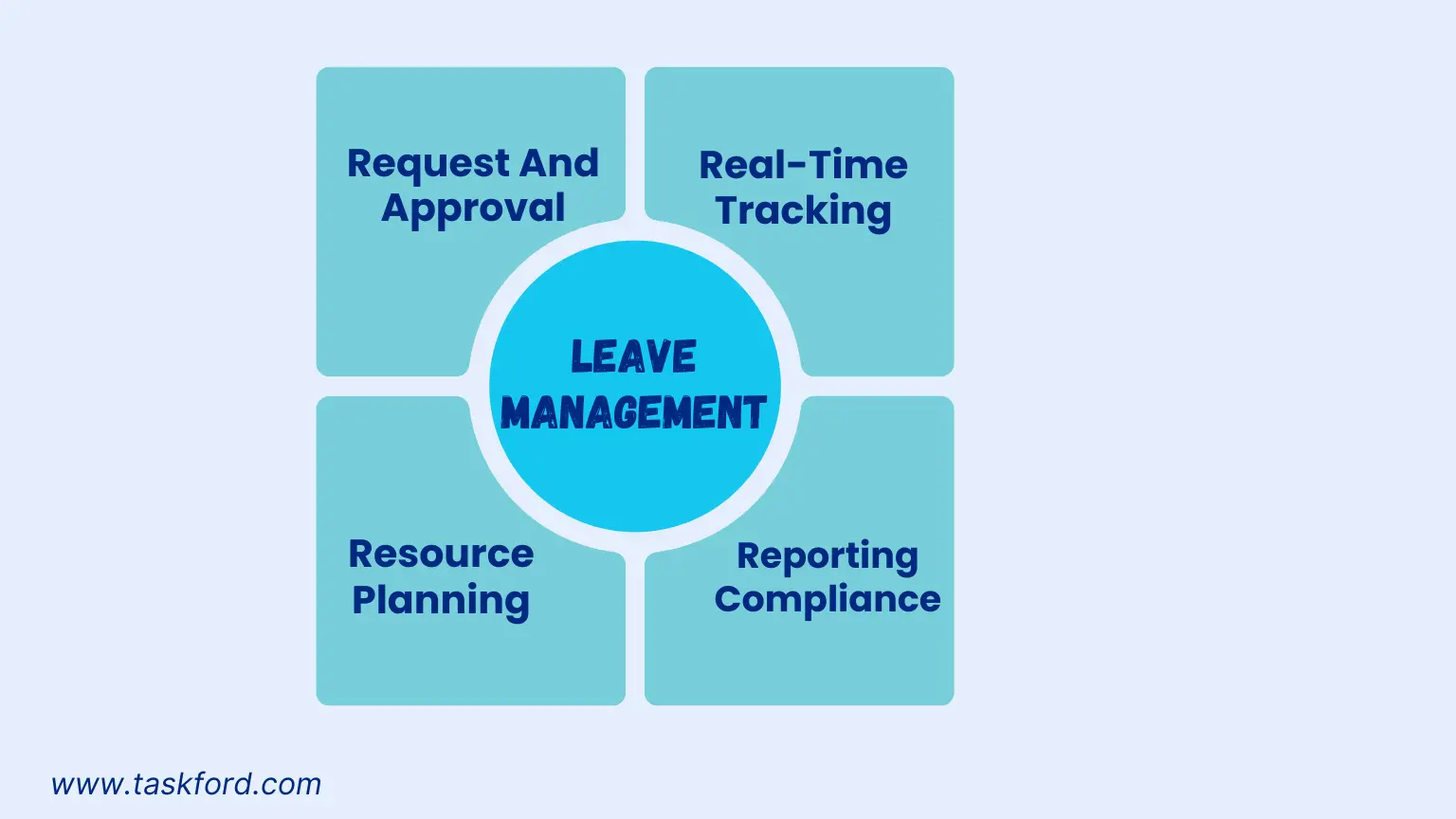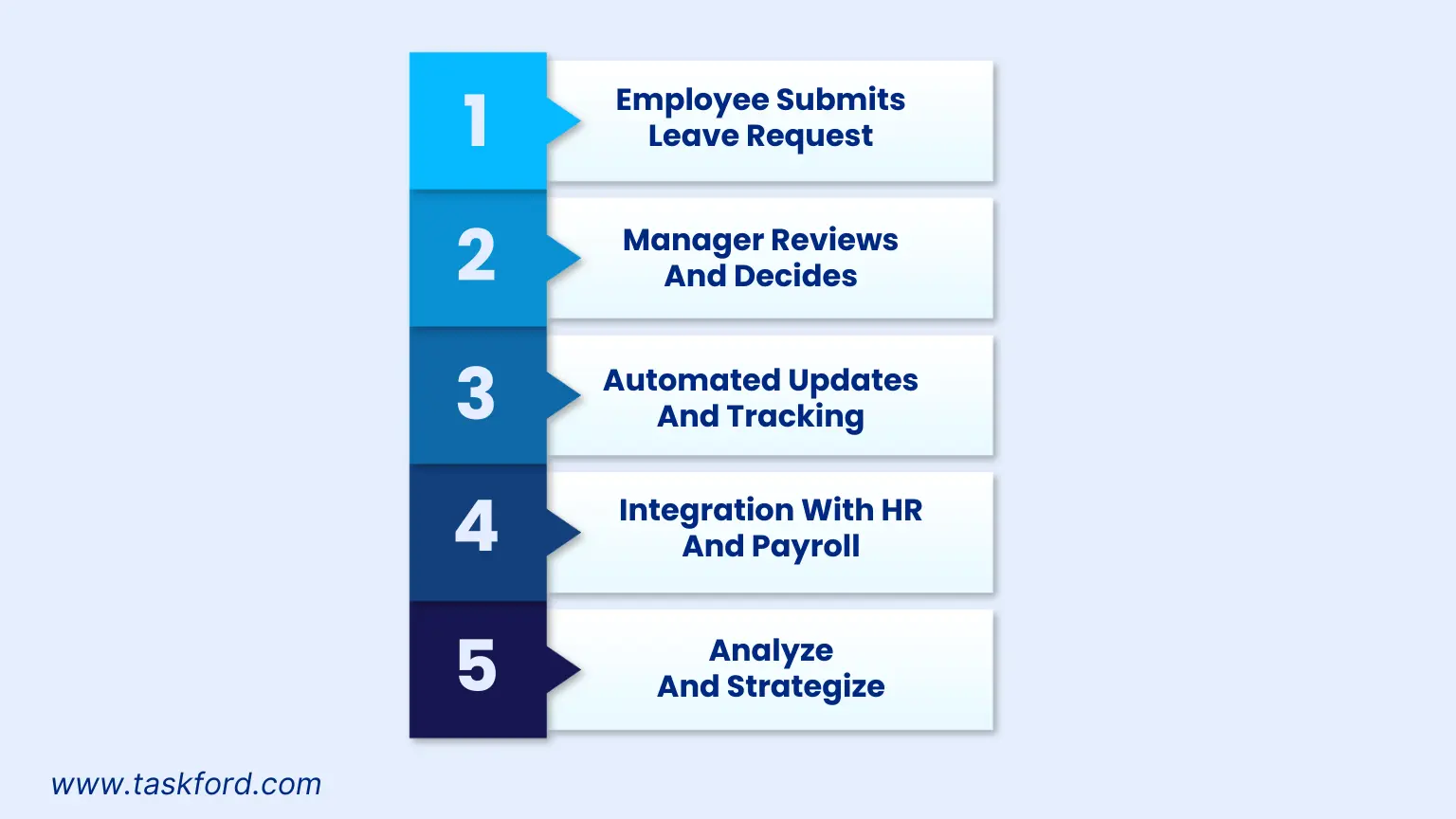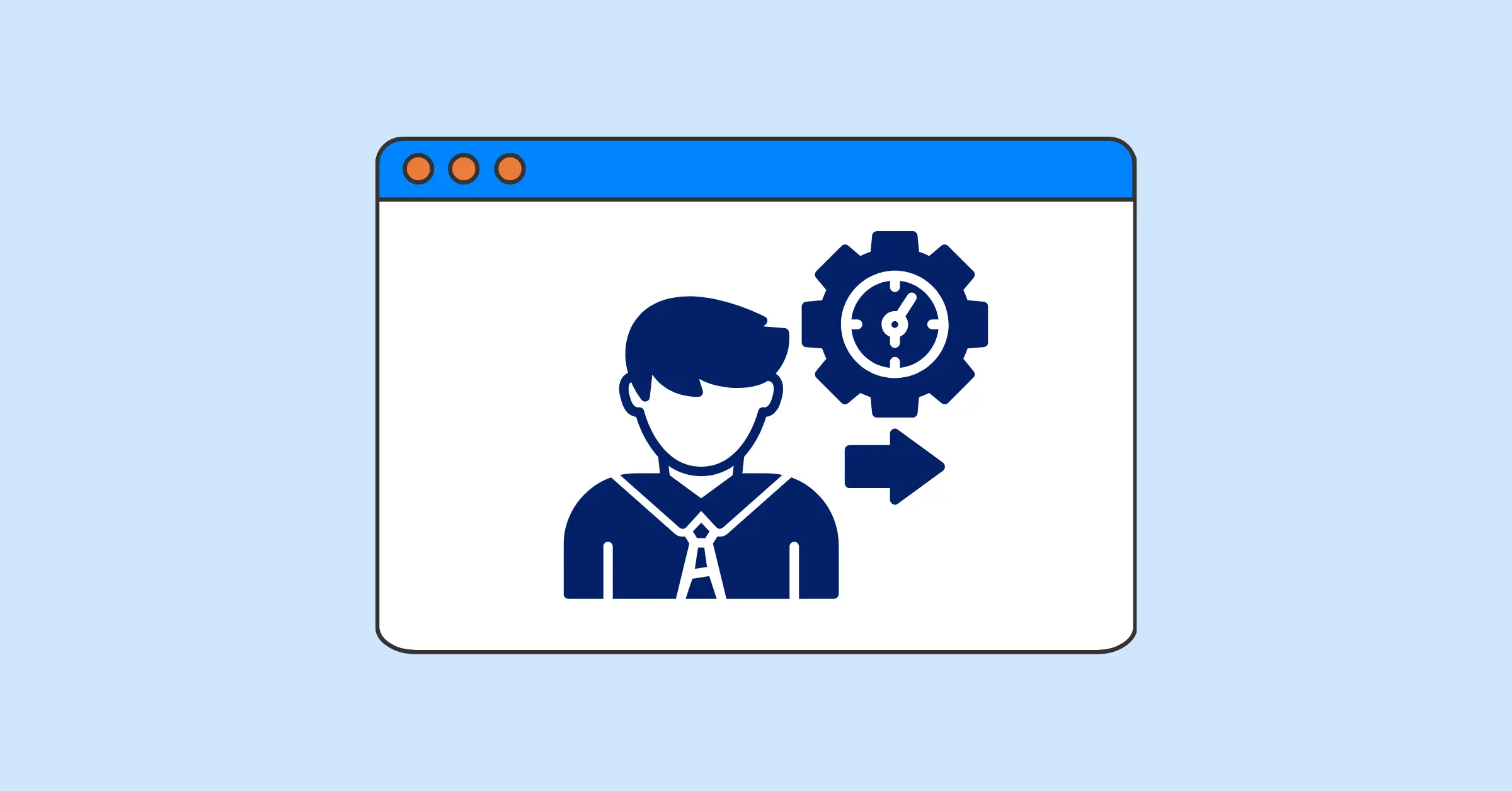What Is a Leave Management System and How Does It Work?
Discover how a leave management system simplifies absence tracking, improves efficiency, and enhances resource planning across all modern organizations.
Effective employee leave management is a cornerstone of organizational success, directly impacting productivity, employee morale, and compliance with labor regulations. A leave management system is a software solution designed to automate and optimize the process of tracking, approving, and managing employee absences. By integrating leave management with resource management and resource planning, businesses can ensure operational continuity while fostering a supportive work environment.
This in-depth guide explores the mechanics of leave management systems, their transformative benefits, implementation strategies, and how TaskFord’s solution leads the way. It provides actionable insights and serves as a foundational resource for modern HR practices.
Understanding a Leave Management System
A leave management system is a digital platform that automates the administration of employee absences, replacing inefficient manual methods like spreadsheets or paper-based forms. It centralizes leave-related data, offering real-time visibility into absence records, leave balances, and approval statuses for HR teams, managers, and employees. The system manages various absence types, including vacation, sick leave, maternity/paternity leave, bereavement, unpaid leave, and public holidays, while ensuring compliance with laws such as the Family and Medical Leave Act (FMLA) or region-specific statutory entitlements.
Beyond simple tracking, these systems align with resource management to maintain adequate staffing levels and support resource planning by providing data for project scheduling and workforce allocation. This integrated approach minimizes disruptions, enhances organizational agility, and supports strategic decision-making. For example, a manufacturing firm can use leave data to schedule maintenance during low-staff periods, ensuring production targets are met.
Core Components of a Leave Management System

A robust leave management system is built on key functionalities that create an efficient, transparent process:
- Leave Request and Approval Process: Employees submit requests through a user-friendly portal, specifying dates and leave types. Managers receive automated notifications to review requests, considering team schedules and operational needs before approving or denying.
- Real-Time Leave Balance Tracking: The system automatically updates leave balances, providing employees with clear visibility into their entitlements and reducing disputes over accruals or miscalculations.
- Calendar and Resource Planning: Shared calendars display approved absences, enabling managers to align leave schedules with project timelines and optimize resource allocation for operational continuity.
- Compliance and Reporting: The system tracks mandatory leave entitlements and generates detailed reports to ensure compliance with labor laws and provide insights into absence trends for strategic planning.
These components form a cohesive framework that enhances efficiency, transparency, and alignment with organizational goals.
How Does a Leave Management System Work?

A leave management system operates through a series of automated processes that optimize absence management. Here’s a detailed look at its functionality:
Step 1: Employee Submits a Leave Request
Employees log into the system through a web portal or mobile app to submit their leave request. They can:
- Select the type of leave (vacation, sick, parental, etc.)
- Enter start and end dates
- Attach supporting documents such as medical certificates
The system checks the employee’s leave balance to prevent over-allocation.
This self-service process empowers employees to manage their own time off and reduces HR’s administrative work. For example, an employee planning a two-week vacation can instantly see if they have enough leave without going back and forth with HR.
Step 2: Manager Reviews and Decides
Once submitted, the request goes to the manager through automated notifications by email or in-app alerts.
Managers can view:
- The employee’s leave history
- Team schedules and overlapping absences
- Project timelines and critical periods
This helps managers make informed decisions. For example, a manager might deny a request during an important testing phase to keep the project on track.
All actions are logged to create a transparent audit trail that supports accountability and reduces disputes. Managers can also adjust the leave type based on the employee’s situation.
Step 3: Automated Updates and Tracking
Upon approval, the system updates the employee’s leave balance and adds the absence to a shared calendar, providing visibility to relevant stakeholders. For instance, a project manager can see that a key developer will be absent during a sprint and reassign tasks to maintain momentum. If the request is denied, the employee receives a clear explanation, fostering open communication and minimizing frustration. This automation eliminates manual updates, reducing errors and saving time.
Step 4: Redirecting to HR and Payroll
The system is then being used by HR to reflect approved absences in compensation calculations. For example, unpaid leave is automatically flagged for payroll adjustments, ensuring accuracy and eliminating manual errors that could cost thousands annually. Having resource management tools allows organizations to align leave data with project schedules, optimizing workforce planning. A retail chain, for instance, can adjust store staffing during holiday absences to maintain service levels.
Step 5: Analytics for Strategic Insights
Advanced systems include dashboards and reports that show leave trends such as:
- Seasonal spikes in vacation requests
- Frequent sick leave in specific departments
- Unused vacation balances
These insights help HR identify underlying issues. High sick leave may indicate stress, while unused vacation could suggest burnout risks.
For example, a tech company noticing many summer vacations can plan cross-training or temporary hiring to maintain coverage.
These data-driven insights improve resource planning, strengthen employee well-being, and support strategic workforce management.
Benefits of a Leave Management System
A leave management system delivers transformative benefits that extend beyond administrative efficiency. Here’s an in-depth exploration:
1. Operational Efficiency and Cost Savings
Automating tasks like balance calculations and approval tracking frees HR teams from repetitive work. A mid-sized company with 200 employees might save 25-35 hours monthly on leave-related tasks, allowing HR to focus on strategic initiatives like talent development. By reducing errors such as overpaying for unearned leave, organizations can save thousands annually. For instance, a single payroll error across 50 employees could cost $5,000, but automation prevents such losses, enhancing financial efficiency.
2. Enhanced Resource Management and Planning
Real-time visibility into employee availability enables precise resource planning. Managers can assess team capacity before approving requests, ensuring critical projects stay on track. For example, a construction firm can avoid scheduling absences during a tight project deadline, reassigning tasks to maintain progress. This alignment with resource management minimizes disruptions and maximizes workforce utilization, directly impacting project delivery and client satisfaction.
3. Compliance and Risk Mitigation
Navigating complex labor laws, especially for global organizations, is a significant challenge. A leave management system tracks mandatory entitlements, such as FMLA or EU statutory leave, and maintains auditable records. Non-compliance with FMLA can result in fines exceeding $10,000 per violation, but automated tracking ensures adherence without manual oversight. For multinational companies, the system can adapt to region-specific regulations, reducing legal risks and ensuring consistent compliance.
4. Improved Employee Experience and Retention
A transparent, self-service system empowers employees to manage their time off with confidence. Real-time access to leave balances and prompt approvals demonstrate respect for employees’ time, boosting morale. Organizations with clear, accessible leave policies see up to 15% higher retention rates, as employees feel valued and supported. For example, a healthcare provider using a leave system reported a 10% increase in employee satisfaction scores, attributing it to faster approvals and clearer communication.
These benefits collectively drive efficiency, compliance, and a positive workplace culture, making leave management systems indispensable.
Challenges of Manual Leave Management
Manual processes, such as spreadsheets or paper forms, create significant inefficiencies:
- Error-Prone Tracking: Miscalculations of leave balances lead to disputes or payroll errors, costing organizations thousands. For instance, overpaying for unearned leave across 100 employees could result in a $10,000 loss annually.
- Time-Intensive Administration: HR teams spend hours processing requests, diverting focus from strategic priorities like employee engagement.
- Limited Visibility: Without real-time data, managers struggle to align leave schedules with resource planning, risking project delays or understaffing.
- Compliance Risks: Manual tracking increases the likelihood of non-compliance with labor laws, exposing organizations to legal penalties.
A leave management system resolves these issues by automating processes, ensuring accuracy, and providing actionable insights.
TaskFord: A Great Leave Management System Option

Among project management tools, TaskFord’s leave management system is a part of a comprehensive project management and resource planning platform designed to simplify absence tracking, enhance resource management, and ensure compliance. Tailored for organizations of all sizes, it combines advanced functionality with ease of use.
Why TaskFord Excels
- Automated and Customizable Processes: Employees submit requests via web, with customizable approval workflows to match policies. For example, extended leaves can require multi-level approvals, ensuring thorough review while maintaining efficiency.
- Combined Resource Planning: TaskFord’s shared calendar along with resource management capabilities, allowing managers to align leave schedules with project timelines, ensuring operational continuity during absences.
- Compliance and Analytics: The system tracks local labor laws and provides detailed analytics on leave trends, enabling data-driven decisions and compliance assurance. For instance, HR can monitor sick leave patterns to identify wellness needs.
- Flexible Uses: TaskFord can also be used by the HR department, ensuring accurate compensation and unified workforce data, reducing administrative overhead.
TaskFord prioritizes data security with encryption and role-based access, and its multi-language support caters to global teams. By choosing TaskFord, businesses gain a reliable partner for optimizing leave management and resource planning.
Best Practices for Implementation
To maximize the system’s impact:
- Define Clear Policies: Establish leave types, eligibility, and approval processes to ensure consistency and transparency.
- Train Stakeholders: Provide extensive training to drive adoption and minimize confusion among employees and managers.
- Leverage Flexibility: Implementing the system with resource management capabilities to create a unified HR ecosystem.
- Monitor and Adapt: Use analytics to track leave trends and adjust policies to align with organizational needs.
The Future of Leave Management Systems
Emerging technologies are shaping the future:
- AI-Powered Insights: AI can predict absence trends and recommend approval decisions, enhancing resource planning.
- Wellness Integration: Systems may integrate with wellness programs to address health-related absences, improving employee well-being.
- Global Scalability: Advanced systems will better support multinational organizations, accommodating diverse regulations.
These innovations will further strengthen the role of leave management systems in workforce strategy.
Conclusion
A leave management system is a powerful tool that automates absence tracking, ensures compliance with labor laws, and enhances resource management and workforce planning. By addressing manual process limitations, it drives efficiency, transparency, and employee satisfaction. TaskFord’s leave management solution exemplifies these benefits, offering a robust platform that integrates with resource planning and payroll systems for maximum efficiency.
For organizations aiming to optimize HR processes and foster a supportive workplace, TaskFord’s leave management system is a strategic investment. Explore TaskFord's offering today to elevate your absence management strategy and drive organizational success.
Learn more
- What Is Resource Planning? Definition, Examples and How to Do it Right
- 5 Steps to Master the Human Resource Management Planning Process
- 5 Critical Mistakes When Using a Resource Planning Program and How to Overcome Them
Making work simpler,
smarter, and more connected
Join our waitlist and be notified first.

Related Blog
Subscribe for Expert Tips
Unlock expert insights and stay ahead with TaskFord. Sign up now to receive valuable tips, strategies, and updates directly in your inbox.



